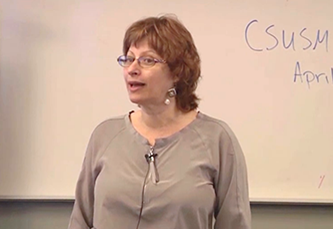 myCSUSM
myCSUSMFlipped Course
"Every class spent lecturing is a wasted coaching opportunity."
- Michael Feldstein, eLiterate
In the flipped course model, Instructors record their lectures or use open-source resources to provide the lecture content. Students can view the videos and complete a short assessment of their content understanding before coming to class. One obvious advantage of this approach is that students complete the required preparation at their own pace and at a time that works best for them.
During class, the instructor functions as a facilitator, coaching, advising, answering questions and addressing misconceptions in real time. Class may start out with a series of mini lectures, further explaining content the students found difficult or confusing. The remainder of the class is spent in active learning, so students and Instructors interact with each other. Most "flipped teachers" think this is the most important aspect of the flipped model.
A growing number of higher ed institutions are investigating its use, and the body of research is growing in the peer-reviewed journals. See for yourself what the research has to say about the effectiveness of the flipped class, and peruse some of the case studies. Then see how Clarissa Bercovitch-Guelman flipped her CSUSM Physics class. Finally, check out the Techniques and Activities page for some ideas for classroom activities.
Peer Instruction & ConcepTests
In the STEM disciplines, the flipped classroom often incorporates Peer Instruction and ConcepTests, a technique developed by Harvard Physics professor Eric Mazur. A ConceptTest is a short conceptual question designed to give students opportunities to apply their learning. In Peer Instruction, the instructor may give a brief explanation or lecture, followed by the ConceptTest, usually in the form of a multiple choice question. Students first respond to ConcepTests individually, often using a student response system (clicker). The % of students answering each response is then shared, and students are asked to discuss their response with their peers, followed by a second opportunity to answer the question. The cycle completes with a final review or activity to clarify any incorrect responses.
Tools for Videocapture
- To record your presentation, faculty and staff can download Camtasia Studio from the Campus software page. Students can download Adobe Premiere. The finished video can be uploaded to YouTube Unlisted or Microsoft SharePoint/OneDrive.
- Zoom, a webconferencing tool free to all CSUSM faculty and students can also be used to record presentations. Recorded presentations can be uploaded to YouTube as unlisted or Microsoft SharePoint/OneDrive.
- EdPuzzle is a free online tool that allows you to take existing videos from YouTube, Khan Aademy and many other websites, add your voice, insert comments and questions and track the students views and question responses. This 7 minute tutorial will get you started.
Ensuring your Students Come to Class Prepared
6 ideas for homework and online interaction that feed into class meetings
The Watch, Summarize, Question Technique
Techniques and Resources
Fipped Class
- How to Make the Most of the Flipped Classroom - ideas from 5 Professors
- 6 Expert Tips for Flipping the Classroom
- What if Students Revolt? - Techniques to Combat Student Resistance
- The Flipped Classroom: Tips for Integrating Moments of Reflection
- Techniques and Activities for Active Learning
- Recommendations for Making Active Learning Work







